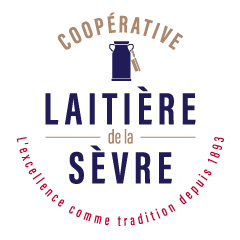HISTORY
A rich region and determined individuals
The geological history of the Deux-Sèvres region has contributed to the generosity of the region’s soils, composed mostly of jurassic limestone. Covered with red clay or alluvium silt, our region is well-suited to certain cultivation, such as alfalfa,
Rich in protein, alfalfa contributes to feed autonomy for livestock farms and to the production of high-quality milk.
In archaeological excavations in the region, goat bones dating back to 3,000 BC have shown that local inhabitants farmed these lands well before the Roman conquest of the Galatians.
During the Iron Age, a strong proportion of bovine cattle overtook the goat populations, on repeated occasions in the Poitou pasture system.
In the 13th Century, Echiré, which boasted a highly strategic position, and Celles-sur-Belle, a major pilgrimage stop, were protected and favoured by the Counts of Poitou, and by the Kings of France and England.
In the 1880s, the phylloxera epidemic devastated the wine-growing activity which, at the time, played a huge role in the region’s development. Our region was thus faced with an environmental, social and economic crisis.
Regional agriculture was reinvented through the development of dairy production. The French dairy cooperative movement really boomed in the Charentes, Deux-Sèvres and Vendée regions in the late 19th Century.
There was a union of dairy producers.
There was an union of Dairy producers. La région où la collecte du lait s’organise, constitue le cœur historique de la coopération laitière. It was in this strong>historic milk pool that the Sèvre et Belle and Echiré cooperatives were founded, in 1893 and 1894.
The butter-making boom considerably accelerated in that period. The international renown was immediate and the Echiré cooperative received first prize at the Exposition Universelle in Paris in 1900, in the butter category.
At the time, the newspapers sung the praises of “a magnificent organisation from the Société Coopérative“.
However, the agricultural sector was once again faced with immense challenges with the two world wars. The effects were instant, and in 1914, the Coopérative Sèvre & Belle experienced hard times.The Great War’s impact was marked by a significant increase in the production price of milk and, in turn, butter.
In 1939, the situation was highly concerning, and the activity was subject to major disruptions. Cooperative producers rallied together to take on the situation, despite the shortages of livestock, hay, straw, coal and fuel…
After the difficult period of the two world wars, the cooperatives regained the upper hand by developing and modernising.
In March 1945, in Echiré, producers were carrying out the first animal tuberculosis screenings, a good example of their avant-garde livestock farming practices.
In 1949, in Celles-sur-Belle, our teams were producing the first traditional goat’s cheeses. Once again, the region proved its resilience by producing cheeses using goat’s milk.A new dynamic would then set the goat system in Poitou apart from other regions in France.
On a national level, the regional goat sector played a key role. On a European level, France was the only country to group all of the expertise and savoir-faire in goat farming, with the majority located in Poitou-Charentes. Anglo-Saxon countries later drew inspiration from the French models originated in Poitou to develop their goat sectors.
As time passed, the reputation and renown of the Echiré and Sèvre & Belle cooperatives continued to flourish.
In 1977, Prime Minister Raymond Barre visited the dairy, congratulating the directors of Sèvre & Belle for the path they had paved for the sector through the implementation of a modern system, and encouraging the company to set its sights on exporting. In parallel, in 1979, the Charentes-Poitou butter became the first French butter to be awarded the qualification of Protected Designation of Origin.
Echiré was part of the small group of butters to be the first in France to receive this qualification.

La modernisation de la coopérative Sèvre et Belle se poursuit.De nouveaux fromages d’exception voient le jour grâce à l’innovation et à la recherche, développées au sein de la Coopérative : le Chevrot en 1982 et le Cabridoux en 1988, fromage au lait cru à longue conservation, plus adaptés aux marchés mondiaux
In 1997, the Echiré and Sèvre & Belle producers worked together to define two guidelines for milk production. Guarantees of quality and flavour for consumers, these guidelines covered the production of goat’s milk (for cheese) and cow’s milk (for butter) but were based on requirements which overlapped. Maintaining the pioneering mindset found throughout their histories, from 1997 onwards, the two cooperatives committed to a guarantee for milk produced from animals with GMO-free diets..
In 2004 our two centuries-old dairy merged to create the Coopérative Laitière de la Sèvre (CLS), inheriting a culmination of exceptional traditional know-how. En 2019, après une restructuration interne, la CLS s’engage officiellement dans une démarche RSE. In 2019, after internal restructuring, the CLS officially committed to a CSR protocol. In 2021, it upgraded its Milk Production Quality Guidelines, to ensure that it maintained its avant-garde edge over good livestock farming practices. An independent cooperative operating on a human scale, a company was founded in a new millennium, with ancestral savoir-faire and exceptional dairy products.


